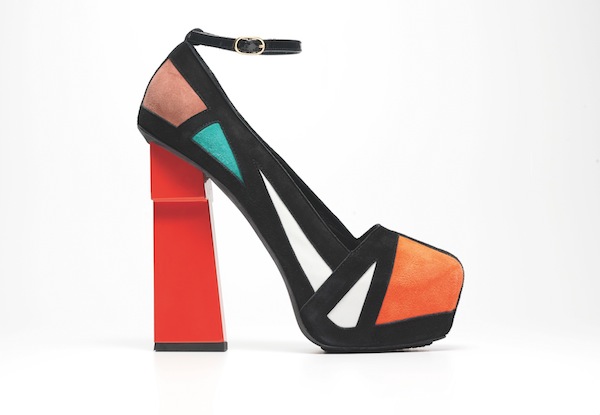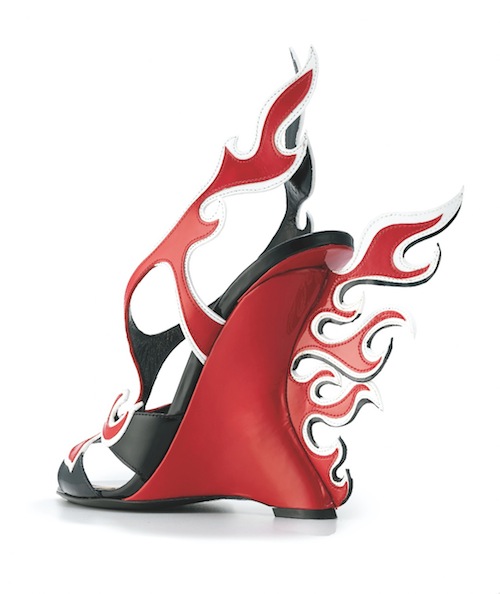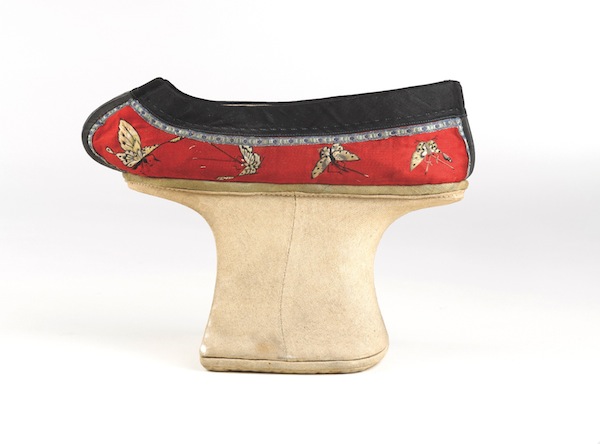
There’s an old saying that “the higher the hair, the closer to God.”
Swap hair with heel, and Killer Heels: The Art of the High-Heeled Shoe, on display at the Palm Springs Art Museum from Sept. 5 through Dec. 12, is practically holy.
Evoking the design and cultural history of the high heel, the exhibition features innovative creations that take the art of the shoe to new and unwearable heights. Familiar names like Manolo Blahnik and Fendi share the space with emerging designers such as Winde Rienstra and Steven Klein. According to Lisa Small, curator of the original exhibition at the Brooklyn Museum, “The high heel is a kind of fashion object, but also a cultural object that has so many rich connections into a variety of moments in history.”

photo by jay zukerhorn
Aperlai, Geisha Lines, 2013, leather, courtesy of Aperlai.
She explains that although a big part of the cultural impact of the high-heeled shoe is about “glamour and fetish,” this is just one aspect of the exhibition and hardly the only story a high-heeled shoe can tell. In addition to the sheer visual pleasure derived from the shoes as design objects, Killer Heels explores issues of empowerment and disempowerment as symbolized by the heeled shoe while offering insight into the history of material culture.
Although all three basic variants of the high heel are represented — stiletto or separated heel, the wedge, and the platform — the thematic arrangement of the shoes is specifically designed to stimulate dialog. Are high heels symbols of sexuality or subjugation, meant to keep wearers down even as they elevate the arches of their feet?

photo by jay zukerhorn
Prada, Wedge Sandal Rosso, Bianco, and Nero Leather, 2012, courtesy of Prada USA Corp.
Are heels meant to be useful, instruments of seduction, objects of art, or allof the above? Do heels suggest confidence and agency, or are they tools of a patriarchal system? Designers and artists consciously employ these contradictions in their creations. As a result, Killer Heels is “not just about stilettos,” according to Small, but “about elevated shoes,” and this notion of elevation holds political and cultural significance.
Palm Springs curator Mara Gladstone agrees, saying the exhibition showcases “the ways that shoes have served to empower women more recently, but traditionally were meant to show a social status that had to do with immobility; having others do things for you.”
A Syrian platform shoe from the late 19th century was designed, for example, so that “your feet wouldn’t be spoiled by the reality of the street: The taller you were, the more it showed your status.”

Photo by Jay Zukerhorn
Winde Rienstra, Bamboo Heel, 2012, bamboo, glue, plastic cable ties, courtesy of Winde Rienstra.
The Palm Springs exhibition is organized into several sections highlighting the historical moments reflected by particular design trends. Revival and Reinterpretation engages a Eurocentric aesthetic, with shoes inspired by furniture and royal fashion. The red sole of a Christian Louboutin shoe is derived from shoes kings wore in the 17th and 18th century. “If you came back with your heels soaked with blood,” Gladstone explains, “it meant you had a successful hunt.”
Metamorphosis invokes transformation, utilizing feathers and furs, horns and bones, and wings that suggest flight. In this section, Small notes, “the whole notion of prostheses was forefront in my mind.” Like the late designer Alexander McQueen, who built heeled “shoe-legs” for amputee models on catwalks, this section of the exhibition plays with the idea of the cyborg, and how inanimate objects are integrated into the body, such as the Céline shoe with a texture that mimics human skin.
Space Walk features design objects that pay tribute to the aerospace industry and the rise of plastics. As a whole, Killer Heels reflects our historical moment, a contemporary design landscape characterized by a new materiality and a willingness to experiment with forms that challenge assumptions about high heeled shoes. In keeping with this idea, Gladstone utilized the lofty ceiling heights in the museum’s rotating exhibition space.

photo by jay zukerhorn
Christian Louboutin, Printz, 2013, courtesy Christian Louboutin.
“We decided to keep it very open,” Gladstone says, noting that the shoes, installed on arched pedestals, will appear to “float in the space,” allowing visitors to explore all sides of the objects and their histories as they wander.
The exhibition design, far from static, illustrates how “the history of fashion is translated to our contemporary sensibilities.” Presented with the shoes are six videos commissioned by artists who purposely engage with the politics of fashion to provide additional opportunities for viewers to interact with these objects, to go as deep — or as high — as they like. Shoes, Gladstone reminds us, can tell us what is happening in a culture.
“These objects hold a life of their own through the stories that they can tell.”
After seeing Killer Heels, you may think differently about your shoes, and about how your feet touch — or don’t touch — the ground.

photo by sarah desantis, brooklyn museum
Chinese, Manchu woman’s shoe, 19th century, cotton, and embroidered satin-weave silk, Brooklyn Museum, Brooklyn Museum Collection.